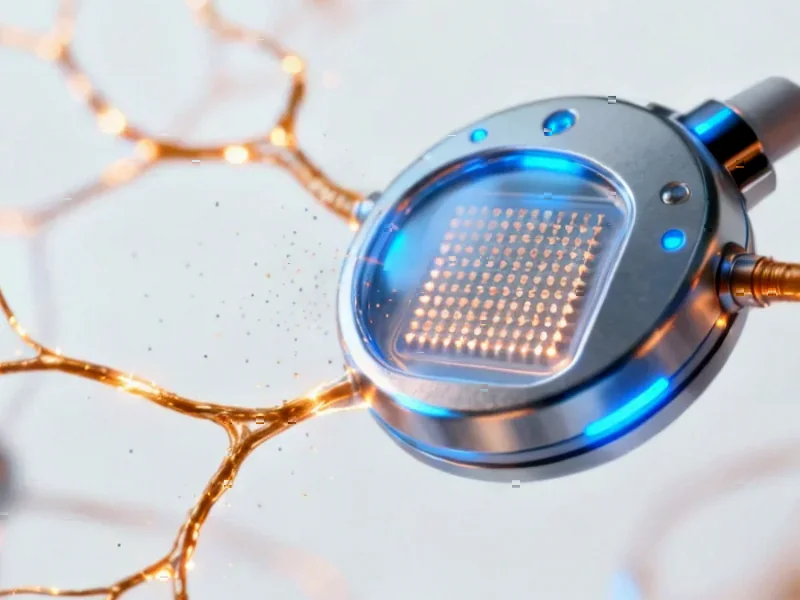Revolutionizing Neuroscience with Correlative Imaging
In a groundbreaking advancement for neuroscience research, scientists have developed an innovative methodology that bridges the gap between neuronal activity and molecular structure. This approach, known as Correlative Voltage imaging and cryo-Electron Tomography (CoVET), represents a significant leap forward in our ability to understand how electrical activity translates into structural changes at the molecular level. By combining live-cell functional imaging with high-resolution structural analysis, researchers can now directly correlate a neuron’s electrophysiological behavior with its underlying molecular architecture.
Table of Contents
- Revolutionizing Neuroscience with Correlative Imaging
- The CoVET Methodology: A Technical Breakthrough
- Optimizing Neuronal Culture for Correlative Imaging
- Electrophysiological Characterization and Clustering
- From Functional Imaging to Structural Analysis
- Revealing Molecular Correlates of Neuronal Activity
- Future Applications and Implications
The CoVET Methodology: A Technical Breakthrough
The CoVET system represents a carefully engineered solution to one of neuroscience’s most challenging problems: how to study the same neurons both functionally and structurally. The approach begins with voltage imaging of living neurons, followed immediately by cryo-preservation and subsequent high-resolution imaging using cryo-electron tomography. This sequential imaging strategy ensures that the functional state captured during voltage imaging is preserved for detailed structural analysis.
Customized Hardware Design: A crucial innovation in the CoVET system is the specially designed grid holder that accommodates coculture systems of neurons and astrocytes. This stainless steel holder features a doughnut-shaped design with a central stepped hole precisely engineered to securely hold transmission electron microscopy (TEM) grids while maintaining compatibility with commercial optical imaging chambers and electric field stimulators. The 18mm outer diameter was specifically chosen to ensure broad compatibility with existing laboratory equipment.
Optimizing Neuronal Culture for Correlative Imaging
Traditional high-density neuronal cultures, while beneficial for neuronal health through enhanced synapse formation and chemical exchange, present significant challenges for single-cell analysis. The CoVET approach addresses this through a sophisticated sandwich culture technique that maintains neuronal health while achieving the optimal density for individual cell identification.
Key innovations in culture methodology include:, as as previously reported
- Low-density seeding: Approximately 45,000 cells/cm² were seeded onto specially prepared grids
- Feeder layer optimization: Astrocyte feeder layers cultured on paraffin wax dots provided essential support
- Surface preparation: Gold grids with carbon film coating underwent glow-discharging, UV sterilization, and sequential coating with poly-D-lysine and laminin
- Optimal sparsity achievement: The system achieved approximately 15,000 cells/cm by the first day in vitro, enabling clear identification of individual neurons
Electrophysiological Characterization and Clustering
The voltage imaging component of CoVET employs the voltage-sensitive probe BeRST1, selected for its exceptional brightness, linearity, and response kinetics. Combined with Hoechst nuclear staining, this allows for comprehensive functional characterization of individual neurons. The imaging configuration positions neurons facing downward toward the objective lens of an inverted epifluorescence microscope, ensuring unobstructed visualization despite the grid structure., according to technology insights
Electric Field Stimulation Validation: Through detailed electric field simulations, researchers confirmed that their stimulation system delivers an average field strength of 1089 V/m to neurons on the grids—sufficient to reliably evoke action potentials. Validation experiments using non-excitable HEK293T cells confirmed that observed responses were specific to neuronal activity.
Response Heterogeneity and Clustering: Analysis revealed significant variability in neuronal responses, ranging from consistent action potentials to weak, irregular, or completely absent responses. Using Hierarchical Clustering Analysis based on peak value, decay parameter, and reproducibility, neurons were classified into three distinct electrophysiological clusters: strongly responsive, moderately responsive, and non-responsive populations.
From Functional Imaging to Structural Analysis
The transition from live imaging to structural analysis represents one of the most technically challenging aspects of the CoVET methodology. Following voltage imaging, the entire perfusion chamber containing the grid holder is transferred to a plunge freezer, with grids subsequently separated and vitrified using one-sided blotting to minimize disturbance to cultured neurons. Critically, the entire process from voltage imaging to vitrification is completed within 15 minutes, preserving the functional state captured during imaging.
Targeted Cryo-ET Analysis: By assigning specific electrophysiological identities to each neuron during voltage imaging, researchers can perform targeted cryo-electron tomography on neurons with known functional characteristics. This electrophysiology-guided approach minimizes subjective bias and enables more accurate interpretation of structural findings.
Revealing Molecular Correlates of Neuronal Activity
The power of the CoVET approach is demonstrated by its ability to reveal previously inaccessible relationships between neuronal function and molecular organization. Initial findings indicate that ribosomes in neuronal somas from different electrophysiological clusters exhibit distinct translational landscapes and spatial networks. This suggests that electrical activity patterns directly influence the protein synthesis machinery at the molecular level.
Technical Advantages: The CoVET methodology offers several significant advantages over traditional approaches:
- Direct correlation of function and structure in the same cells
- Minimization of inter-sample variability through same-cell analysis
- Ability to study rare neuronal subpopulations based on functional characteristics
- Preservation of native molecular states through rapid vitrification
Future Applications and Implications
The CoVET platform opens new avenues for investigating the molecular basis of neuronal function, synaptic plasticity, and neurological disorders. By bridging the gap between electrophysiology and structural biology, this approach promises to transform our understanding of how electrical activity shapes molecular architecture in healthy and diseased nervous systems. The methodology’s compatibility with various optical devices and stimulation systems ensures its broad applicability across neuroscience research domains.
This technological advancement represents a significant step toward comprehensive understanding of neuronal function at multiple scales, from network activity to molecular organization. As the methodology continues to evolve, it may provide crucial insights into the structural basis of learning, memory, and various neurological conditions.
Related Articles You May Find Interesting
- European Study Reveals Remote Work’s Impact on Urban-Rural Divide and Workforce
- Advancing Biomechanical Research: Comprehensive MRE Datasets and Cutting-Edge In
- Harnessing Nanobodies to Degrade YAP Protein: A Breakthrough in Cancer Therapy
- Revolutionary Multimodal Microscope Unveils Real-Time Brain Activity in Awake Mi
- Unlocking the Brain’s Predictive Power: How 7 Tesla fMRI Reveals Our Body’s Inte
This article aggregates information from publicly available sources. All trademarks and copyrights belong to their respective owners.
Note: Featured image is for illustrative purposes only and does not represent any specific product, service, or entity mentioned in this article.



